The British defence
at
Villers-Bocage
Commander of B Squadron 4th CLY, Major Aird, was anxious to
see if it was possible to reach A Squadron at ‘Point 213’ and
he ordered 4th Troop under commando van Lt. Bill Cotton to
look for a southern route to the hill. When they reached the
train station it became obvious to Cotton that it was
impossible to make a breakthrough. Instead he headed into the
centre with his unit.

Left stands Capt. Bill Cotton MC
with his crew,
promoted after the battle for
Villers-Bocage
(notice the Iron Cross on his Luftwaffe
jacket)
Lt. Bill Cotton and his 4th Troop installed an ambush position
at the square in front of city hall. Central became the
Sherman Firefly with as support two Cromwell tanks
(there was a third Cromwell, a close-support 95mm howitzer
that was not suited for tank-versus-tank). A 6-pounder
anti-tank gun, of the 1st/7th Queens, was also brought into
position at the square. Beside the anti-tank gun there were
PIAT’s among the infantry.

An example of the PIAT (Projector, Infantry, Anti Tank)
Meanwhile, a part of Panzer Lehr Division under command of
Gen.-Lt. Bayerlein was heading for Villers-Bocage. Major
Helmut Ritgen had collected 15 PzKpfw IV. When this unit approached
Villers-Bocage from the north, it was fired upon and stopped
by anti-tank guns. Panzer Lehr and the 1./s.SS-Pz.Abt. 101
headed from the north and north east with support of
panzergrenadiers and Waffen-SS. From the south some vehicles
from 2. Panzer Division were rolling into Villers-Bocage.
The Tiger tanks of 1./s.SS-Pz.Abt. 101 moved into
the streets of Villers-Bocage. 4th Troop had the engines of
their tanks shut down and they were listening how the low
growl, cracking and wining of German tanks headed their way.
Lt. Cotton had the close support Cromwell moved out of sight
and was on foot to look into the Rue Pasteur to see how the
situation was developing. The first tanks that were
approaching were two PzKpfw IV of Panzer Lehr Division. They
were both put out of action by the anti-tank gun of 1st/7th
Queens.

The PzKpfw IV of Panzer Lehr
Division that moved furthest
into Rue Pasteur before it was
stopped
The first Tiger, ‘121’, moved with caution into the
square where Sergeant Bramall had his Firefly
positioned. The first shot flew over the top of the turret of
the Tiger because the gunner could not use his sight on
the short distance. A direct hit of a 6-pounder eventually
stopped the Tiger.

De Tiger '121' knocked out
in the Rue Pasteur
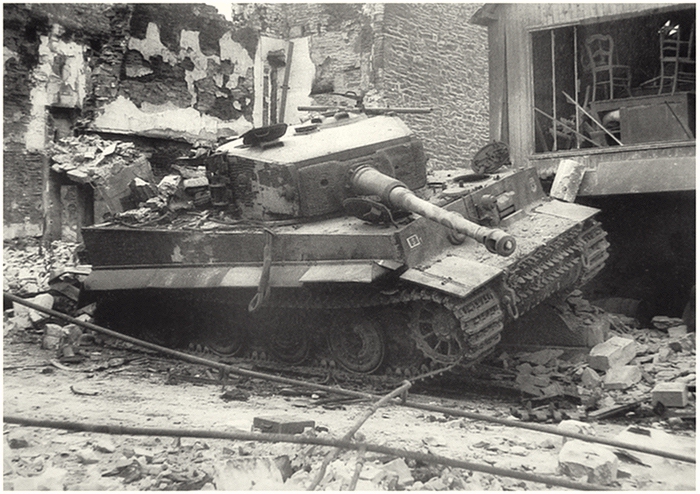
To prevent that all of the Tigers would be stuck in
one street, some were moving through gardens to the south in
trying to encircle the British troops. South of the main
street, Rue Pasteur, were three streets parallel to it, the
Rue Saint-Germain, the Rue Emile Samson and the Boulevard
Joffre. Through these streets the Tigers moved to the
west. Wittmann, in his drive into down a couple of hours
before, was smart enough not to seek a fight in the narrow
streets, Möbius sent his heavy tanks through the small
streets. He must have known that in every corner the danger
lurked of anti-tank weapons, nevertheless he went for the
confrontation. The Tiger which was moving through
Boulevard Joffre was stopped by a shot of a 6-pounder
anti-tank gun. The next Tiger, that was rumbling along
through Rue Emile Samson, was stopped by a PIAT. Also the
Tiger coming down Rue Saint-Germain was knocked out by
a PIAT.
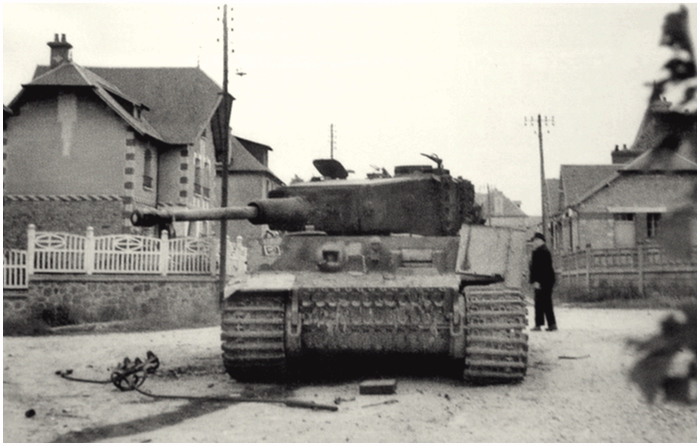
The knocked out Tiger I on
the crossing
Rue Jeanne Bacon and Rue Emile Samson, Then
and Now
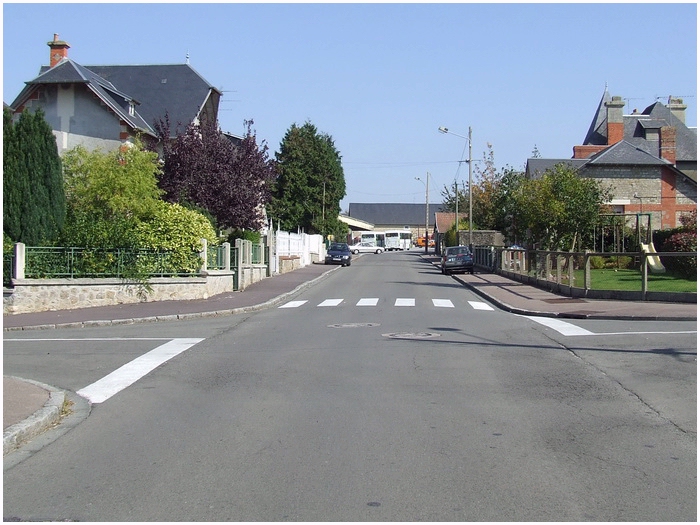
In the Rue Pasteur a second Tiger moved with
caution. The crew knew that somewhere to their left was an
ambush position with anti-tank guns. Just as it reached the
square the Tiger stopped. Sergeant Bramall in the
Firefly could see the German steel monster through
windows connecting the side wall and the front of the
building. To bring out a shot, he had to reverse the
Firefly a couple of meters. He traversed the turret so
the barrel could fire through the two windows. The gunner was
unable to line the weapon with its visor and had to look
through the barrel to aim it. He fired two shells but they
both bounced of the mask of the Tiger. First thing that
was observed was, that the Tiger moved back.

The Tiger was finally put
out of action
notice that the turret has moved to the
ambush position.
Probably because another Tiger ('212'?) was behind
him, the commander decided to drive pass the ambush position.
The heavy turret with the deadly 8,8cm gun turned towards the
square, during the drive, to look for a British target. But
the shot that was given was a British one, when a shell hit
the weak rear of the Tiger. It rolled on for a couple
of meters and came to a standstill next to the earlier knocked
out PzKpfw IV.

The ‘torched’ '121', set afire by
Bramall and Cotton
During a lull in the fighting, Sergeant Bramall and Lt.
Cotton took some blankets and a jerrican with gasoline. With
this they drenched three knocked out German tanks and set them
alight. Preventing that the Germans would recover them later.
Cotton was to become the Military Cross and Bramall the
Military Medal for courage and the defence of Villers-Bocage.
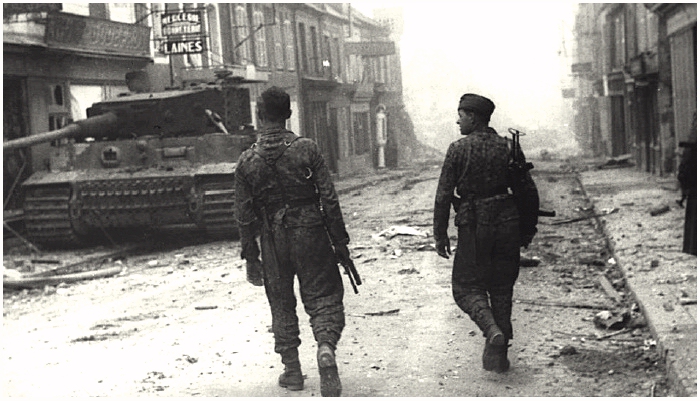
This is the knocked out '212' in
Rue Pasteur
(notice that the nose of this Tiger
points eastwards)
A short distance from the square and the ambush position of
Cotton the Tiger '212' was put out of action. When it
was knocked out it was facing to the east, towards ‘Point 213.
Was it driving reverse to give protection to the other
Tigers and their weak rear or had it just made a
neutral turn in Rue Pasteur? Some sources give this as the
Tiger of Wittmann, but the location where it stands
makes that option impossible. Wittmann was stopped much more
to the east near the crossing heading towards
Tilly-sur-Seulles.
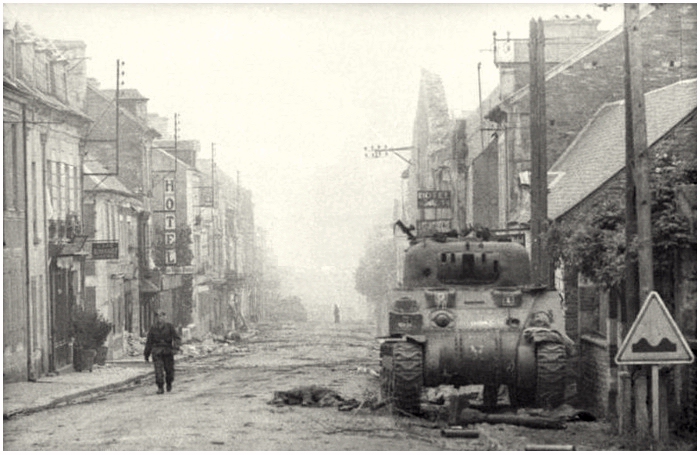
Left in the smog the '212' is
visible, so it is not possible that this is the
Tiger
of Wittmann, he turned back when he reached
approximately the Hotel
The street fighting in Villers-Bocage was fruitful for the
British, six Tigers and (probably) three PzKpfw IV.
Around 16.00 hours the British troops still held out in
Villers-Bocage. But German mortar and artillery fire was
descending in a heavy quantity and drove the British slowly
out of town and to the west. At the train station A Company
was over run and a complete platoon was taken prisoner. Also
the headquarters of 1st/7th Queen’s was almost surrounded.

The train station of Villers-Bocage
at the Boulevard du 13 Juin 1944,
now a restaurant of a factory,
still bears the scars of battle
Brigadier Hinde ordered the 22nd Armoured Brigade to retreat
out of Villers-Bocage and move to a better position than in
the narrow streets of the town. Under a smokescreen and a
barrage of artillery from K Battery, 5th Royal Horse
Artillery, the British troops retreated a couple of kilometres
west of Villers-Bocage, into the so called ‘Island Position’.
For a map with the points of battle
in the afternoon in Villers-Bocage
CLICK HERE.
The losses were high for the 7th Armoured Division. It lost
378 men, killed, wounded or taken prisoner. Beside the human
losses, a lot of material was lost. The 22nd Armoured Brigade
lost 20 Cromwell tanks, 4 Sherman Fireflies and 3 M3A3 Stuart
tanks. Further more, 28 other vehicles were lost, like Half
Tracks, Universal Carriers, Scout Cars etc. of the
reconnaissance units.
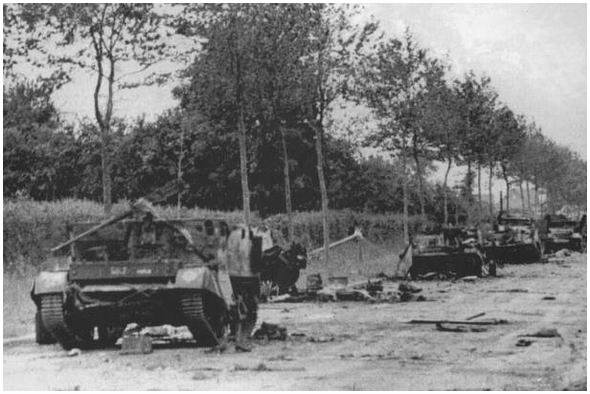
The destruction is enormous on the
road towards 'Point 213'
The area where the British consolidated (the ‘Island
Position’) was created west of Le Mesnil and north-east of
Tracy-Bocage, left and right of the D71. All men were tensed
and tired after a day of fierce fighting in Villers-Bocage.
But, beside some artillery fire and German sniper action, the
night from 13 and 14 June was reasonably quiet. The next day
it was noticed the Germans had almost encircled the ‘Island’,
like a horseshoe. The road the British had once took was, from
Amayé-sur-Seulles was still open and was fast taken by a
British patrol. But the noose got tighter. The whole day and
the next night the Germans were probing in the defence, but
this held under the pressure. This was also due to the
assistance of artillery from the American 155mm guns of the
1st US Infantry Division, who gave support to the artillery of
the 5th RHA units of the 22nd Armoured Brigade. Furthermore,
the 3rd RHA, 5th Army Group Royal Artillery and a battery of
the 64th Medium Regiment and two 52nd Heavy Regiment artillery
batteries gave support to the stricken troops. Also RAF
Typhoon fighterbombers were looking for German targets.
On 15 June the Germans attacked a couple of times which
made some casualties to the 22nd Armoured Brigade. At some
points the attackers got threw the first line of defence, but
the second line held every time. Around 19.00 hours the most
serious attack came from the south and from the north-east.
5th RHA G, C and K Battery shot 1400 grenades in three hours.
Three company’s infantry with support of three Tiger
tanks put up a fierce attack, but the artillery of the 5th RHA
laid a bloody barrage of fire and stopped the German attack.
Between the 700 and 800 casualties for the Germans were the
result and some eight tanks were destroyed. After 22.00 hours
the fighting died. Two and a half hours later the retreat from
the ‘Island’ could commence. To support the retreat, the RAF
bombed Aunay-sur-Odon which gave it a perfect diversion. The
Germans were slow to respond and the remaining troops, which
were part of Operation Perch, pulled back behind the
Allied lines near Livry.
What went on after Operation Perch at
Villers-Bocage?
click
below.
|